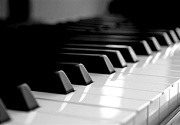
Home > Beginner Piano Lessons > Understanding the Piano Keyboard
|
|||||
Understanding the Piano Keyboard
It may seem like a huge challenge to start understanding a piano keyboard for a beginner. However, once you know the basics you will be able to name every key on the keyboard and move on to learning other aspects of playing the instrument. The piano keyboard is divided up into octaves. An octave is a group of eight notes. So, if we start on middle C an octave consists of the notes C, D, E, F, G, A, B and C. This can either be ascending or descending. This pattern repeats itself ascending up the piano keyboard and descending down the piano keyboard. It is therefore not difficult to master the names of the keys on the keyboard when you know where to locate the keys on the keyboard and that every eighth note will repeat itself either an octave higher or an octave lower on the keyboard. Typically, beginners learn to understand the piano keyboard by learning to locate middle C on the keyboard. As the name signals, middle C is positioned almost exactly in the middle of the keyboard. Try to find the middle of the keyboard and look for two white keys next to each other. The second white key which is not broken up by a black key is middle C. From there, a semitone up is D and then E and so on.
When a key is played this felt-covered hammer hits a corresponding string which has a unique tone and tension associated with it and bounces back. The string then reverberates creating the sound you hear when a key on the keyboard is pressed. It is important to familiarise yourself with a keyboard when you are starting out to play the piano. Sit at your piano and play each note, run your fingers up and down the keyboard and get a good overall picture in your mind of your keyboard. It is also useful to perhaps stick notes on each key of the keyboard to remind you of the name of each key. There are many resources on the internet which can better help you understand the piano keyboard where sites are dedicated to specific lessons on showing you the piano keyboard and where for example middle C is placed, playing semitones and the notes on the written music stave are located on the piano. Learning to understand the piano keyboard is both practical and theoretical. You need to have a good understanding theoretically of the notes of the notes, where they are located on the stave as well as practically which means sitting in front of you piano and familiarising yourself with the position of certain notes and moving your fingers fluidly along the piano.
http://pianoplayerworld.com/300PagePianoWorkbook.html
| |||||
|
Although every attempt has been made to make information as accurate as possible, we are not responsible for any errors that may appear.
 A standard piano has 88 keys on its keyboard. There are 36 black keys which
are sometimes referred to as “sharps” and 52 white keys.
A standard piano has 88 keys on its keyboard. There are 36 black keys which
are sometimes referred to as “sharps” and 52 white keys.
 By pressing a key on the piano keyboard, a sound is emitted from the piano.
This happens because every key on the keyboard is connected to a felt-covered hammer.
By pressing a key on the piano keyboard, a sound is emitted from the piano.
This happens because every key on the keyboard is connected to a felt-covered hammer.



